 A giant post with recommendations on South Korea
A giant post with recommendations on South Korea
✈ location: South Korea
/ No comments
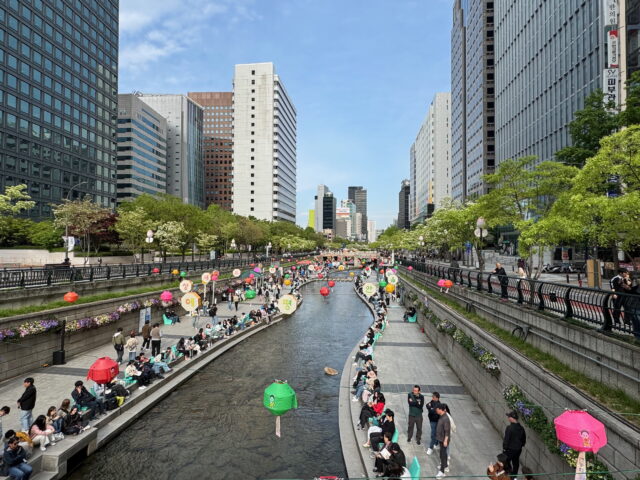
Where my lovely wife was more into describing our adventures in South-Korea in a detailed and observant way, i think this would be a good opportunity to make a more ‘what we learned from visiting Korea’ post. As in: if you ever have the idea of visiting the land of morning calm (and you should) here are a couple of things that we learned that will help you as well.
Context
My wife and I (we’re both in our fourties) traveled around South Korea around April 2025. I mostly limit my tips to ‘things to do and see’, because restaurants and hotels change so quickly. You can read more about how we found lodging and restaurants later in this post.
TL;DR
All of these points will be elaborated in more detail later on in this post.
Essentials
- Bring a creditcard.
- Install the Naver app.
- Get an eSim with a dataplan.
- Get the T-money card.
Itinerary
We had four weeks and could have seen much more, there’s just so much to see and explore! These are the cities we visited in the order of recommendation.
- You’ll probably fly in and out of Seoul. Seoul is gigantic, and you’ll need at least three full days to see a selection of the most popular sites. There’s something for everyone here.
- Gyeongju has an incredible amount of historic things to see, but also has a nice, laid-back atmosphere. Stay here for at least two full days.
- We only went to Daegu because we did a templestay at the Donghwasa temple here, which was fantastic.
- Suncheon was the biggest surprise for me. Also a nice relaxed atmosphere, a fairly small city, but still lots of nice things to do.
- Busan is good if you like beaches and big cities. It’s a bit bland though. And getting from point A to B with public transport can take a while.
- Gwangju is an all-around big city with a couple of nice things to do, but can be skipped if you have little time.
- Wonju is very much off the beaten track, but it does have Museum San, which is a must-visit if you’re into modern art and architecture. Can also be done as a day trip from Seoul.
- Jeonju is okay. The Hanok village is a bit of a tourist trap (the one in Gyeongju is much nicer) and besides the palace there’s not that much to see here. Also skip if you’re short on time.
We didn’t visit Jeju island so unfortunately i can’t say anything about it.
Deep dive
Okay, now for the deep dive. Here’s everything you need to know when visiting South Korea.
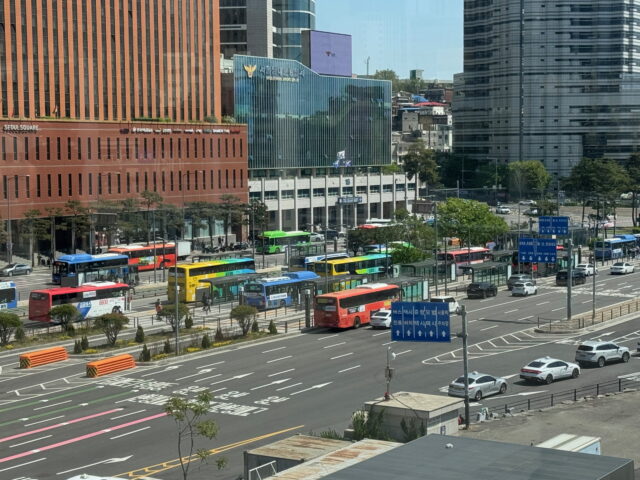
What you’ll need / things to know before you go
- A smartphone with an internet data plan is pretty much essential. The public transport is amazing, but if you don’t want to get stuck asking questions all the time (and people speak little to no English) and figuring out complicated bus timetables you’ll need a smartphone.
- Fortunately data plans are easy to buy using the eSIM system (make sure your phone supports that). We got the one from KT which, depending on the number of days you stay here, will set you back around 3.000 won (about €2) per day but is totally worth it. You can just get a ‘data-only’ plan, you won’t need a plan that also supports calling. These plans works by sending you a QR code, which you should scan a day or so before you leave. They will start from that moment. Make sure to disable the data/roaming setting for your regular plan to avoid high costs. With modern smartphones you can use both your regular SIM and the eSIM at the same time so you can still receive calls and use apps to need access to your regular SIM.
- Once you get to South Korea you’ll need one of the major mapping apps. Google Maps doesn’t give you (walking and transport) directions in Korea, so you need either the Naver or Kakao app. We preferred the Naver app because it tends to have more English texts and labels (although not everything is translated). Kakao can be useful for things you can’t find on Naver.
- Also very useful is the Papago app which translates better to/from Korean than Google Translate. You can also use it to instantly translate images with text to English, like the menus you’ll find in restaurants.
- The k.ride app is kind of like the Korean Uber. You can attach a credit card and enter your destination, making it a bit easier to communicate. Note that you do pay a percentage for using the app. You can also just hail a cab on the street, which is cheaper. Taxis in generals are quite cheap (5000 won for a small ride) and trustworthy. Note that a red sign means the cab is free and green means occupied!
- We had little luck using our Dutch debit cards in Korean ATM’s so you’ll also need a credit card. In most places you can also pay using a credit card.
- The weather can be quite fluky in april! We brought our winter coats which felt like overkill, but in the end they were very useful during the windy hikes along the Busan beach. Make sure to bring clothes that work in all seasons if you’re also going around this time!
- To get around public transport in all cities you’ll need a T-money card. You can get these at most metro stations and the Incheon airport. To charge it, the easiest way is to go to any convenience store (GS25, 7-11, CU) and ask the clerk to charge it while handing over cash. Note that you can’t charge a T-money card with a credit card!
- It’s nice to learn Hangul (the Korean script) and not that hard (because it’s an alphabet, like Latin or Cyrillic) and can sometimes be useful. However, virtually all important signs are also translated in English and there’s always the Papago app.
- In general we found Korea super safe to travel around. Of course you always need to use common sense (make sure to keep your important belongings on you, watch out for pickpockets, etc.). But we were never scammed or had the feeling that we’re paying more because we’re Western tourists.
Transport
Transport in Korea is amazing, as long as you have the Naver app, a credit card and a T-money card (see under ‘Essentials’).
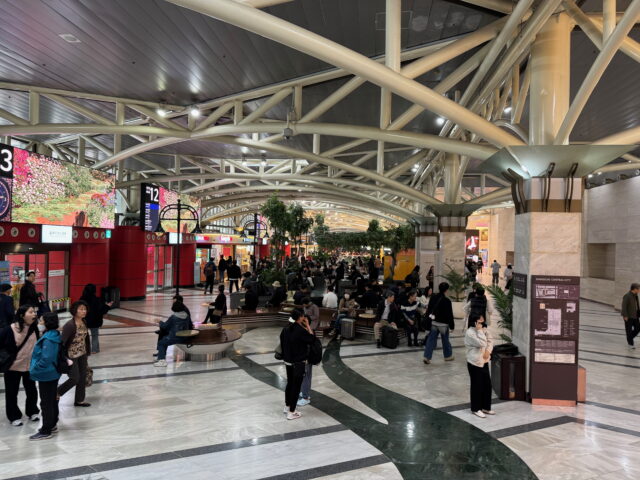
Intercity busses
One of the things that surprised me the most is the fantastic intercity bus network. We’ve travelled before by bus from city to city in other countries and usually it’s a cheap, but gruelling affair. Confusing timetables and stops, and a lot of hassle to buy tickets.
Not so in South-Korea. Bus stations usually look more like luxurious malls, with loads of places to get food and drinks. There are surprisingly well-designed (English) touch displays where you can buy a ticket, and even select the seat you want. It’s very clear where the busses leave and they usually leave exactly on time and arrive exactly on time. It’s almost comical: the first time we took a bus (from Seoul to Jeonju) the bus literally arrived 15 seconds before the scheduled time at the destination. There are many bus lanes in the country, so that also helps in speeding up bus traffic.
The busses are also super comfortable. You get three seats in a row, so lots of leg room and free fast wifi. If you select the ‘premium’ option instead of ‘excellent’ you might even got a touchscreen with movies, like on an airplane.
There is also a train network which is probably excellent as well, but we never used it because the busses were so cheap and comfortable.
It might be wise to buy tickets in advance if you’re going to popular places and there are not that many busses, or traveling on busy moments (e.g. Friday evenings). You can easily reserve / buy tickets in advance from the touch screens in the bus terminals. There’s usually friendly personnel around if you need help.
Public transport
Public transport in cities is usually very good, as long as you have your T-money card and the Naver app. Most cities have extensive bus networks, and the larger ones also have metro lines. You really need the Naver app to understand the bus system. Most busses will call all stops in English and have a screen that shows the stop name in English as well. To check in, simply touch your T-money card when entering the bus and do that again when leaving the bus.
Note that many seats tend to be reserved for the elderly, disabled and pregnant. Using those seats if you don’t fall in those categories will be frowned upon.
City bus drivers tend to drive quite…sporty. So hold on tight whenever you’re standing or walking down the aisle.
Where to stay
Korea has many hotels, guesthouses and dorms. We mostly tried to find smaller hotels and guesthouses. If you don’t speak Korean you’re mostly limited to the regular methods (e.g. Booking.com and AirBnB). Even though we were in cherry blossom season (April) we had little trouble finding accommodation (we only booked the first three nights in advance). It was a bit harder in the weekends, so maybe don’t wait too long with booking your accommodation, especially if there are also public holidays.
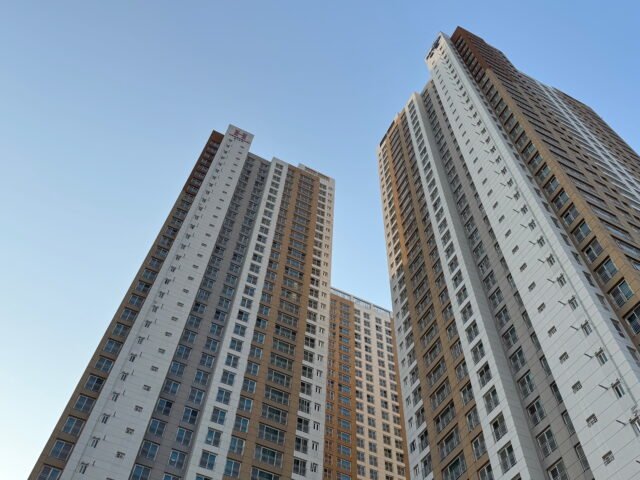
Most guesthouses were very clean, comfortable and full of amenities (e.g. a washing machine, a water purifier). One thing that many hotels do lack is a bit of character. IKEA furniture and rooms without any decoration are rampant. You will also encounter many ‘contactless checkins’ where you just get a couple of keycodes and you check yourself in and out. Make sure you have WhatsApp, which tends to be the most common medium of sending you these codes.
Hotels are pretty cheap compared to most western countries. You can easily find a double in a decent hotel for under 100.000 won (about €60).
Where to eat and drink
Korea has a crazy amount of restaurants, coffee places and bars. Apparently there’s one coffee house for every 500 inhabitants and one chicken restaurant for every 1500. You’ll have no problem finding good places to eat and drink. Once again, the Naver app is useful here in finding the restaurants of your liking. It also usually has the menu of the restaurant right in the app (or at least a picture of the menu). Naver has a couple of useful filters, including one for restaurants that are friendly for ‘solo diners’.
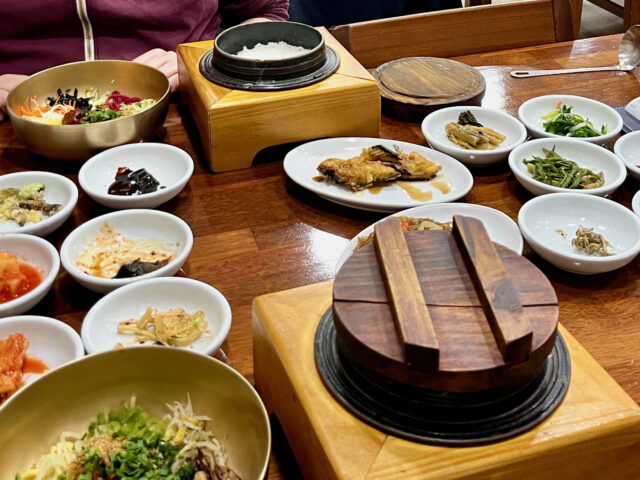
We heard from many people that Korea is very meat-centric, which is true but it’s not that hard to find places that focus more on veggies. If you’re a strict vegan or vegetarian it might be difficult, because meat and fish can be used in unexpected places (e.g. the seasoning used in kimchi).
Some useful things to know when dining:
- Usually you collect your own cutlery. This can be in a hidden drawer in your table, or in a central place in the restaurant.
- Get water at the water cooler for free.
- In the cheaper restaurants you get up and collect your own banchan (side dishes).
- Pay at the counter, not at your table. Most places accept credit cards.
In terms of what you can eat there’s just so much to choose from. Just try something different every night! One way to cheaply try a lot of different dishes at once is going to a ‘buffet restaurant’ (this is also a filter on Naver), which is basically an ‘all-you-can-eat’ restaurant where you can try many different types of food.
There are places with ‘western food’, but unfortunately they tend to be quite expensive (e.g. double the price of what you pay for Korean food) and usually not that great (finding good pizza is hard). The most common non-Korean food is Chinese and Japanese. Ramen places are everywhere.
Breakfast is not really a thing in Korea. For some reason the Koreans really don’t do ‘European bread’, it’s all quite chewy and sweet to be honest. Don’t be fooled by chains with names like ‘Paris Baguette’, ‘Tous les Jours’ and ‘Oma’s Brötchen’: French and German bakers would cry when they would find out what goes around for bread here. There are some good ‘European-style’ bakers but they are hard to find. We found good bread at a small chain called ‘Butter Bakery’ in Seoul.
One thing the Koreans do very well though is coffee. As mentioned, there’s a coffee place on basically every corner. Most of them conveniently allow you to order from a screen with English translations. Make sure you choose the ‘hot’ option if you don’t want to end up with ice coffee, which is very popular here. There are also an incredible amount of non-coffee drinks like fruit juices, sodas and all kinds of weird contraptions featuring large amounts of sugar, cream and sweet stuff. I think we tried all the major chains and in our humble opinion the best chain is ‘Compose Coffee’, closely followed by ‘Paik’s Coffee’. You usually pay around 4000 won (€2,50) for a big latte.
Places
Ok, on to recommendations for the different places that we visited. I tend to write longer about the things that i liked, and less so about the things that i didn’t like that much. The sights at every city are ordered by how much i would recommend them.
Seoul
Well, Seoul has it all. First of all, it’s gigantic. The metropolitan area is home to around 25 million people (this includes cities like Incheon and Suwon), about half of all Korean people live in this area. Even though it’s gigantic there are many places that don’t feel like ‘giant city’ at all, and it’s easy to get around using the extensive public transport network. Just realise that it might take some time to get from one part of the city to another.
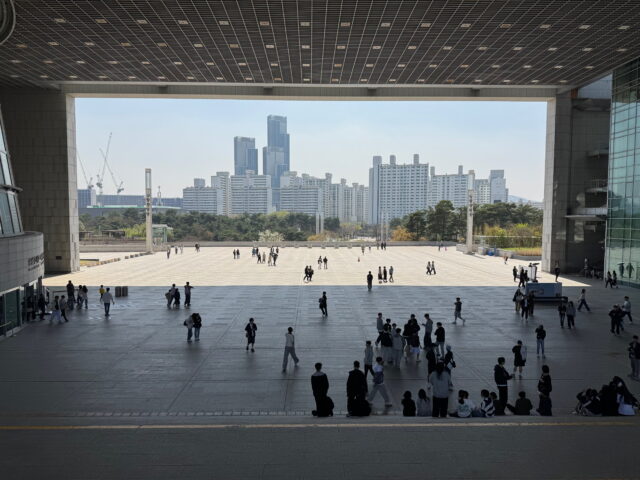
You’ll need at last three full days to explore a couple of the top spots, but you can very easily stay much longer here. We stayed for nine nights. We had a hotel in the Mangwon-dong area (around the Mapo-gu Office and Mangwon metro stops). I can recommend this area. There are loads of nice restaurants and bars, but it ‘s not as busy and touristy as the area around, for example, Hongik University. It’s still very close to most of the sights and you’re also quite close to Incheon airport. Mangwon market is great for sampling lots of different street food.
National Museum of Korea
This major free museum should be on the top on your list. It has three floors full of amazing Korean historic artifacts and art, in a spectacular building with an amazing view. There are free English tours. It’s very big so be prepared to either spend a lot of time here, miss a lot or go twice.
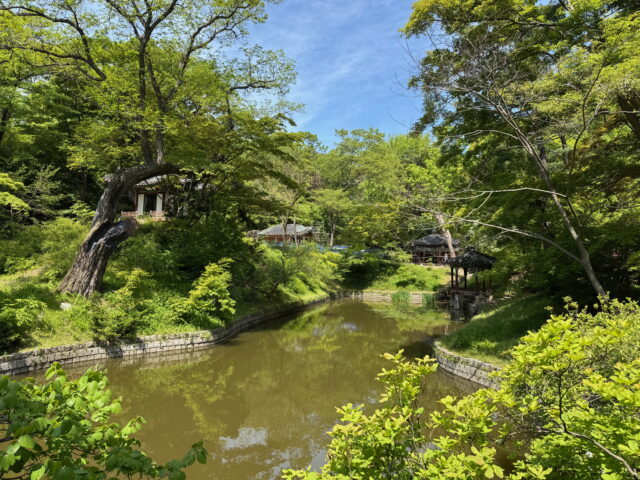
Changgyeonggung Palace & Secret garden
This is the one palace you should visit in Seoul. The palace ground are more diverse and interesting compared to many of the other palaces in Korea that we’ve seen. I also highly recommend the Secret Garden tour, it’s very beautiful and we had a super funny tour guide. Note that you need to buy tickets for the Secret Garden separately, and it might be wise to reserve them in advance. The palace grounds (not the garden) are free if you are dressed in hanbok (traditional Korean clothes) which you can rent in many shops around the palace.
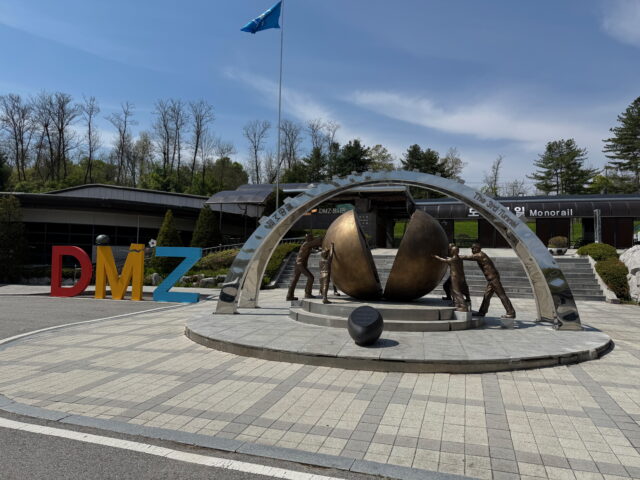
DMZ daytrip
Even though you’re kind of paying to listen to propaganda, a tour to the DMZ is something you should do when visiting Korea. Since 1953 the Korean peninsula has been split up in North and South along a “military demarcation line” (MDL), around the 38th parallel north. Around this MDL there is a so-called ‘demilitarized zone’ (DMZ) 2 kilometers north and south. The daytrips actually don’t take you into the DMZ, but just south of it, in yet another ‘zone’ (the civilian control zone, or CCZ).
Commonly these daytrips include a visit to Imjingang park, with dozens of different monuments. “The third tunnel”, which is one of the four discovered tunnels that North Korea allegedly dug for a hostile invasion. The Dorasan observatory, where you get a close look at North Korea. And “Unification village”, the only inhabited village within the DMZ.
It’s all very strange and weird. Even though you’re in a military environment there are ferris wheels, restaurants and lots of discutable souvenirs (who doesn’t want a DMZ fridge magnet?). It kind of feels like being in a David Lynch movie.
There are a couple of different tour operators. We went with VIP Travel, which costs us around 70.000 won. Word is that all the tour operators offer more or less the same, and the ‘extra stops’ like the red suspension bridge aren’t worth it.
Cheonggyecheon Museum and river
This is a remarkable free museum dedicated to Seoul and the Cheonggyecheon stream. Once a vital lifeline for the city, the stream became heavily polluted after the Japanese occupation as people flocked to Seoul in large numbers. Over the decades following the war, it was covered over and transformed into a highway. In a fascinating turn of events, it was restored as a river in the early 2000s.
Beyond the museum, the Cheonggyecheon stream itself is also definitely worth a visit, particularly on pleasant days. You can enjoy a relaxing stroll along its banks, and you’ll even find free spots with books available to read.
National Museum of Korean Contemporary History
Close to the Geunjeongmun palace, this free museum has a surprisingly good (English) overview of, unsurprisingly, Korean contemporary history. A good museum to view early on in your trip, so you get a bit of perspective on how the Korean peninsula evolved.
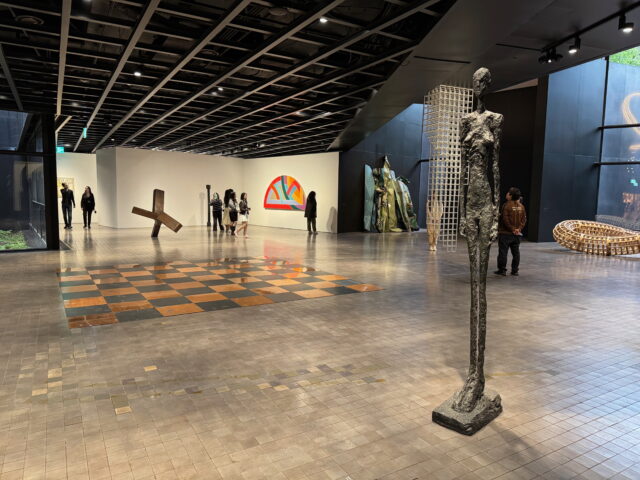
Museum Leeum
The private art collection from Samsung is displayed in this futuristic and highly photogenic building (note: entrance fee). Both the modern and traditional permanent collections are great, and there are good temporary exhibitions here as well.
Arario Museum in Space
This is a private (hence: not free) modern art museum, very close to Changgyeongung Palace. I liked the curation of this museum, which focuses on sombre and gloomy art. Definitely not for everyone, but if you like dark art, this is the place for you. Very weird building (it used to be an office space) as well.
Museum Kimchikan
I thought this would be a tourist trap, but the Kimchi Museum is actually quite good! There’s a lot to see here, and you can even taste different kinds of kimchi! I also highly recommend the excellent vegan kimbap (Korean sushi) place at the ground floor (Maru JaYeonSik Kimbap).
Gangnam
Gangnam is a large neighborhood on the south bank of the Han river, famous because of the rich inhabitants and of course that song by PSY. Gangnam has limited ‘big’ sights, but there are a couple of nice things to see. We liked to walk around the Seonjeongneung park and look at the royal tombs. There is the inescapable Gangnam Style Statue next to the colossal COEX Mall for the obligatory selfie. And next to the mall there’s the meditative Bongeunsa temple.
Daytrip to Suwon
Suwon is a big city (around 1.2 million residents) about 30 km south of Seoul. It makes for a nice daytrip, there are many options to get here. Things you can visit here are the Haewoojae museum, better known as Mr. toilet house, dedicated to …well, you know. You can have a nice stroll around the old fortress walls and climb the Paldalsan mountain for nice views. The Suwon Museum of Art was surprisingly good. A bit more to the west of the centre is the giant Starfield Suwon mall which hosts the Instagram-famous Starfield library.
Seoul Museum of Art
Another free museum, focusing on modern art. I would say it’s worth it alone for the fabulous work by Korean video artist Nam June Paik in the lobby (one of his last before his passing), but if you’re not that much into art you could skip this one.
The War Memorial of Korea
Another giant free museum about Korean military history. Expect lots of school children, tanks and airplanes. It’s okay to get a bit of historical perspective, but for a better explanation i would recommend the National Museum of Korean Contemporary History instead.
Other sights in brief
Seoullo 7017 is an elevated park, reminiscent but a lot less charming then the New York High Line, but worth a visit if you’re in the neighborhood. If you’re there anyway you could also visit take a look at the futuristic Seoul City Hall and the former city hall which is now the Seoul Metropolitan Library. There’s a free rooftop garden with nice views.
If you’re a palace lover you will also probably like the Geunjeongjeon palace. On the palace grounds you can visit the fine National Folk Museum of Korea.
Restaurants
There are a bazillion restaurants in Seoul and i recommend you find your own favourite spots, but here a couple that we liked:
- Oreno Ramen. Great restaurant with a good rich chicken ramen. Has a Michelin Bib Gourmand.
- Butter Bakery. The best “European-style” bread that we had in Korea. Great French-style baguettes.
- Itaewon Uyuk Mien. Best bulgogi we had in Korea.
Gyeongju
Gyeongju is a truly lovely city. It’s packed with historical sights just waiting to be explored, and despite being quite popular with tourists, it maintains a relaxed atmosphere. Part of this charm comes from the fact that its central area avoids the ubiquitous concrete high-rise apartment buildings found in many other Korean cities.
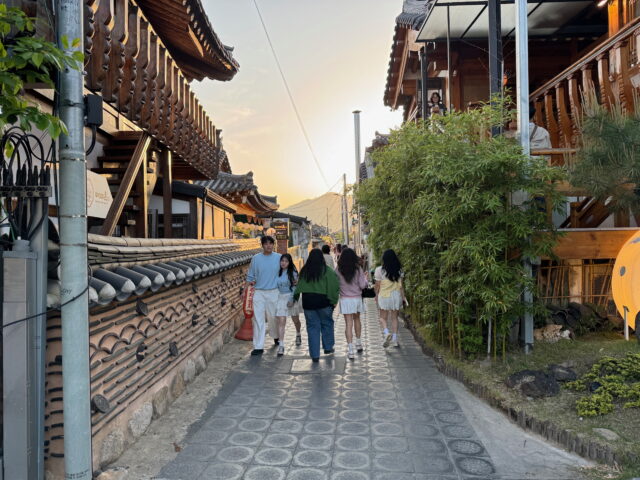
One thing that is not so convenient about Gyeongju is the public transport system. There are busses to all the major tourists sites, but for some reason they tend to run really infrequently (like once every 60-90 minutes or so) and are hard to comprehend, even with the Naver app. Be prepared to wait for a while, get a cab, or rent your own transportation.
Some of the most popular sites are the numerous burial mounds right in the center of the city, the Bulguksa temple up in the mountains and the Donggung Palace.
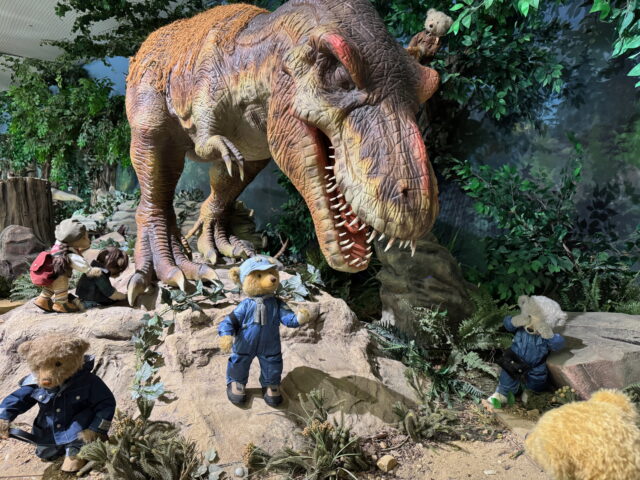
Teddybear and rabbit museum
This is a pretty weird place that has a giant collection of teddybears and other stuffed animals that are put into ridiculous scenes. Expect quirky photo opportunities with teddybears battling dinosaurs in ancient Korea.
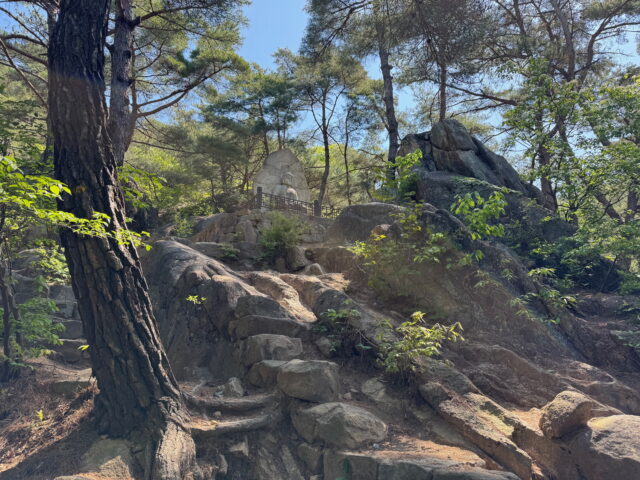
Namsan mountain
There are many walks around this holy mountain, where you can visit countless temples and ancient Buddha statues. A good starting spot for a hike is the Samneung Information Center. I would probably recommend this over the Bulguksa temple if you’re short on time. Bring proper hiking gear.
Gyeongju National Museum
A large free museum explaining the Silla empire with many artifacts from the burial mounds that are aplenty in the city. Excellent free English tours on Sundays.
Sendong market
This is a giant traditional market in the centre. I highly recommend the excellent buffet stalls where you can eat as much as you like for around 9000 won. A bit hard to find, but definitely worth the effort!
Daegu
We only went to Daegu to get a bus to the fabolous Donghwasa temple up in the mountains to do a one-night templestay here, which was amazing. There are templestays all around South-Korea, which can easily be found and booked at the English website. I think most of them are quite comparable, but in our case we got a simple room with private bathroom. We participated in many of the rituals with the monks, including evening prayer and eating in the communal canteen. One of the highlights was ‘tea time’ with one of the monks, who spoke excellent English. Highy recommended.
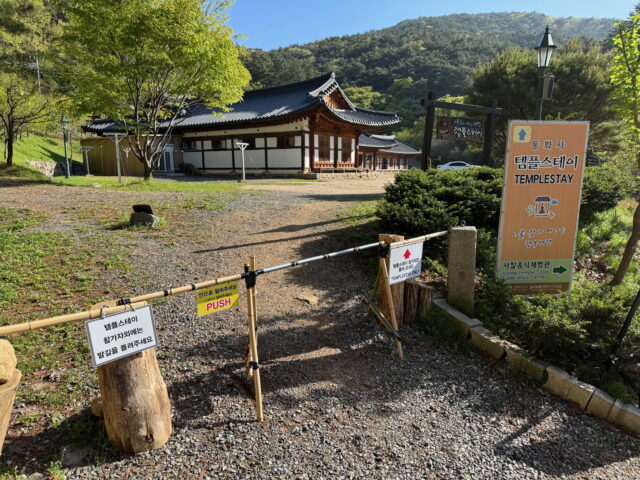
Suncheon
Suncheon was the biggest surprise to me. It’s not on many ‘must-see’ itineraries of South Korea, but it should! It has the same laid-back atmosphere that you also get in Gyeongju, but without all the tourists. Arguably it doesn’t have the same amount of sights that Gyeongju has, but there is enough to see here for at least a full day, and you can easily spend two full days here.
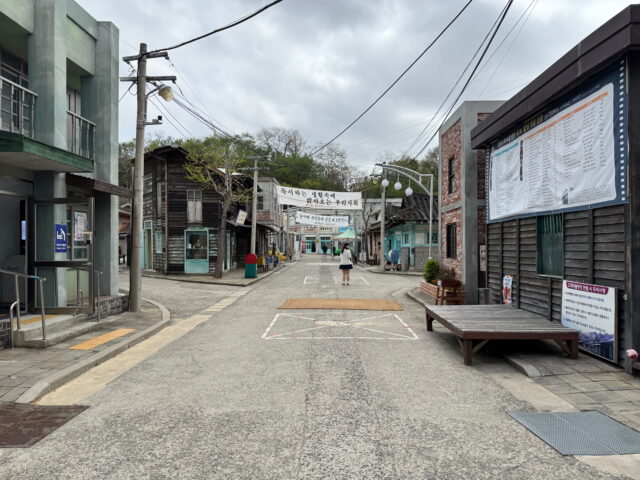
Suncheon National Gardens
The national gardens are the main attraction of the city. Originally opened in 2013, it’s kind of a weird cross between a botanical garden and a theme park. There are lots of cultivated gardens here, but there are also attractions, a pet zoo and a crazy ‘space bridge’. There’s a ‘Sky Cube’, an elevated railway that takes you to the ‘Wetlands’ area in the south of the city. The wetlands are honestly not that interesting, but the train ride is kind of fun.
Open Set
Also known as the Drama Set or Movie Set, this is a large fake city used as a set in many Korean movies. There’s a complete historical town here, but also a more contemporary ‘Korean town’ from the seventies. Lots of silly attraction as well, there’s even a free karaoke booth.
Honam Patriots Memorial Hall
Surprisingly good museum about the different wars the Koreans fought in. And not that gigantic as the War Memorial in Seoul. Also cool because they have a room with about 20(!) VR helmets and shaking seats that they love to use on foreign tourists.
Busan
Busan is a giant city, the second largest in Korea after Seoul. It’s stretched out along the southeastern coast. This also means that transport takes a while. Taking a bus from one side of the city to the other can easily take 90 minutes or more. Be prepared to spend a lot of time in public transport here. Compared to Seoul i think Busan it’s just a bit…bland. Seoul is more dense and layered, making it more vibrant in my opinion. Still, if you like beaches, coast and nightlife you’ll probably love Busan.
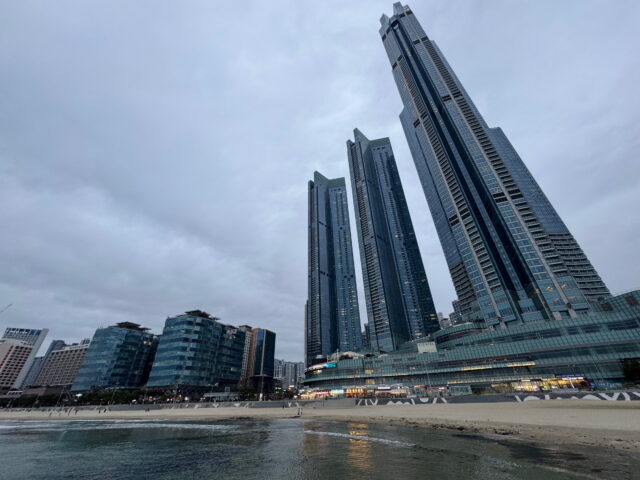
The Museum of Contemporary Art was a bit too highbrow for my taste (it’s also pretty far out of the centre). It’s nice to take a stroll in Gamcheon village, but it’s also very touristy. The National Science Museum is okay, little information in English here although the exhibits look spectacular.
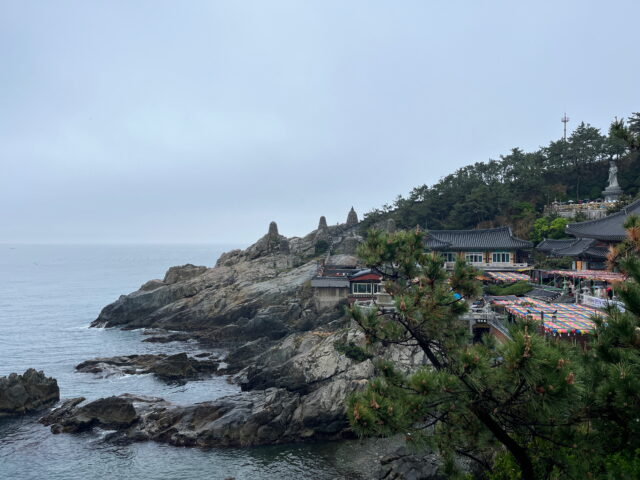
Haedong Yonggungsa
Even though this temple is very touristy, it’s definitely worth it. This temple is built on a spectacular site, on the cliffs next to the sea. We were there on a grey rainy day, and even then it was amazing.
Igidae Coastal Trail
You can make a beautiful hike here along the coast line. The route is very accessible, lots of well-designed steps and bridges and stunning views. Highly recommended.
UN Memorial Cemetery
Pretty close to the coastal trail is this cemetery for UN soldiers who died during the Korea war (1950 – 1953). It’s a meditative and respectful experience which i can highly recommend as well.
Gwangju
Gwangju is your typical ‘big-but-its-not-seoul-or-busan’ Korean city. The city itself is not very inspiring, but it has a couple of nice sights that could fill a day or two. If you’re short on time i would skip Gwangju.
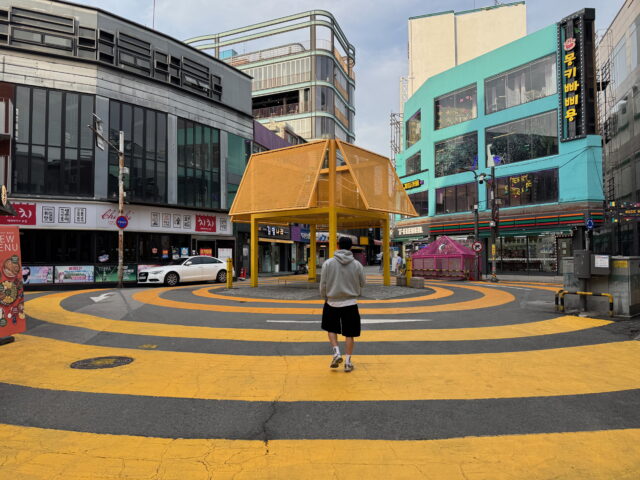
Museums
There is a cluster of three large museums in the northwestern corner of the city: the National Gwangju Museum, the Gwangju Art Museum and the Gwangju Folk Museum. Honestly i can’t remember much from them so they’re probably not that amazing. The National Museum had a couple of interesting items (although you’ll probably see similar items in the National Museum of Korea in Seoul). The Folk Museum had a robot that can be your tour guide, which was kind of fun.
Penguin Village
This is a small neighbourhood around the Yangnimgyo bridge in the southeast part of town. It’s quite pleasant to have a little stroll there and admire the mural art and check out the small shops and bars.
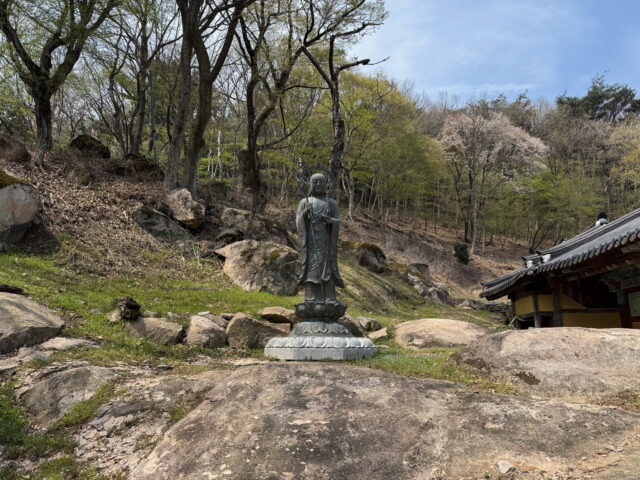
Mudeungsan National Park
A park that’s easy to reach by public transport and where you can do many different hikes. I would recommend taking the 1187 bus and get out at Mudeungsan National Park / Wonhyosa temple.
Jeonju
Jeonju was okay in my opinion. Definitely skippable if you’re short on time. The historical Hanok village mostly consists of restaurants, guesthouses and snack joints, it doesn’t feel very ‘historical’ to be honest. For some reason we visited Deokjin park, which you can certainly skip.
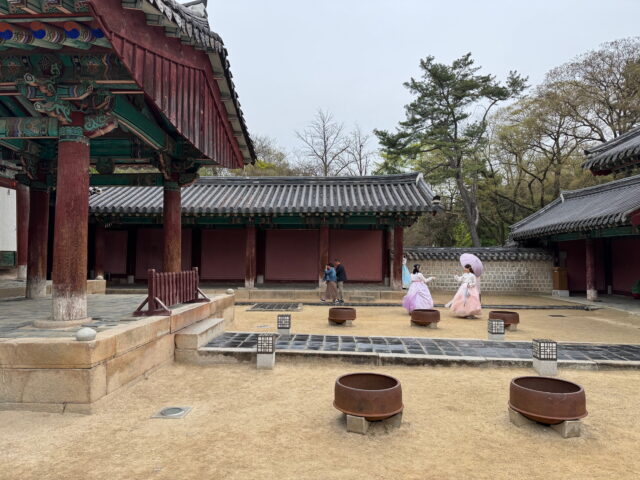
Gyeonggijeon shrine and Royal Portrait Museum
Right next to the Hanok village and worth the effort. Especially the portrait museum has interesting exhibitions and has a couple of really fun things to do for children.
Jeonju National Museum
Excellent museum, with lots of information signposted in English. Next doors History Museum is a bit rundown and shows it age, but it’s free so you can have a look if you’re there anyway.
Wonju
Let’s be frank: Wonju is not on any Korean itinerary. The main reason we visited this place is because we wanted to visit Museum SAN, which is kind of a must-visit if you’re into modern art and architecture. Still, Wonju was surprisingly nice and i can easily recommend this place as a stopover for a night if you’re traveling from Gyeongju to Seoul. Wonju and Museum SAN can also be done as a daytrip from Seoul.
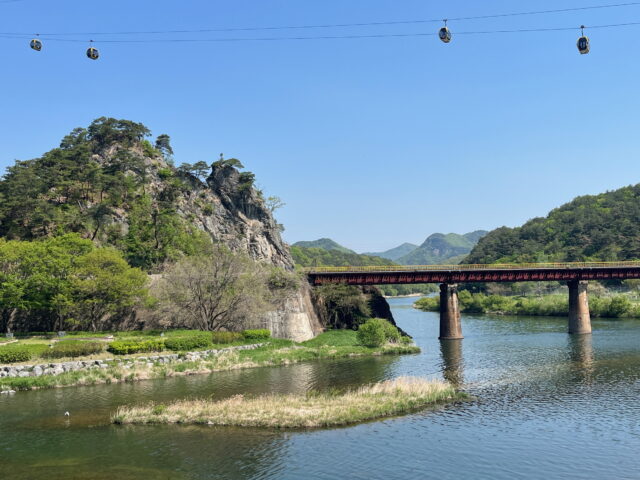
This section is a bit more verbose and specific because there’s a lack of good tourist information about Wonju in English.
Wonju City Tour Bus
An excellent way to see Wonju is by using the Wonju City Tour Bus. This is a hop-on hop-off bus that stops at the major sights, like Museum SAN and the suspension bridge area. For 5000 won (~€3) you’ll get a wristband that allows you unlimited travel on the bus and 20% discounts on all the sights. The bus doesn’t run very often (about once every hour per stop) so you need to time it a bit, but it’s the best way to get to the sights if you don’t have your own car, and a lot cheaper than getting cabs.
Every stop has a scheduled timetable, so you can time your stops very well. You’ll also get a free lecture when you’re in the bus which unfortunately will be in Korean. Also note that the tour bus doesn’t run on Mondays (when Museum SAN is closed anyway). There are multiple stops in the city, including one at the bus terminal and the train station.

Museum SAN
So, the main reason we visited Wonju is this museum. It opened in 2013 and is designed by the famous Japanese architect Tadao Ando. Just the building itself is worth the visit, it’s set on a pretty dramatic mountain top and has spectacular views from within the building. One of the main attractions is a collection of four light works by the American artist James Turrell. There is also a permanent exhibition about Korean paper, a meditation hall and multiple sculpture gardens.
Entrance is a bit expensive. You’ll pay at least 23.000 won (€14) for the ‘basic ticket’, 39.000 (€24) if you also want to see James Turrell and 46.000 (€28) for everything. Remember though that you’ll get a 20% discount if you’ve got the city tour bus bracelet. The museum cafetaria is also very expensive (around 10.000 won for a simple coffee) so bring your own lunch or eat somewhere else if you want to save money.
Sogeumsan Suspension Bridge
This is another main sight of Wonju (and stop on the bus tour). It’s the largest pedestrian suspension bridge in Korea, with a length of 200 meters. We didn’t have enough time to see the bridge, but the area around it is also very nice, with lots of small shops and restaurants around the river. There’s also an impressive looking cable car you can take towards the bridge.
Another ‘attraction’ in the same area is an abandoned railway station. It apparently was in use as a tourist attraction where you can cycle up and down the abandoned train tracks using special carts, but that attraction has, sadly, been abandoned as well.
Other things in Wonju
There is the free Wonju history museum which i guess might be interesting if you can read Korean (there was very little signage in English). There is a nice museum garden, which includes a replica of the childhood home of former president Choi Kyu-hah, who was born in Wonju.
There’s a pleasant park around the river in the centre of the city, around the 치악교 bridge.
I can also recommend to stroll around the Wonju Jungang market for a bit.
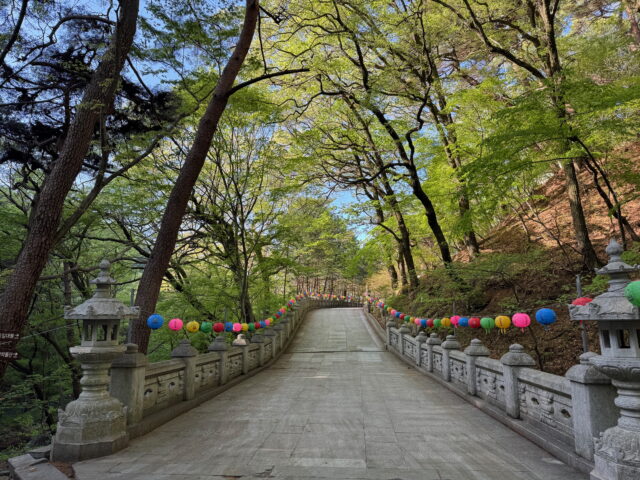
That’s all folks! Congratulations if you read this post all through the end. I hope you have a wonderful visit in South Korea. And do feel free to share this post with other people who might visit South Korea. Or leave a comment if you’ve got more tips.
Add a comment